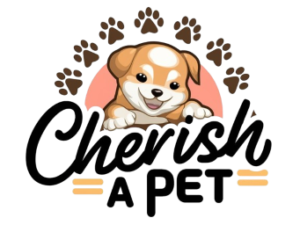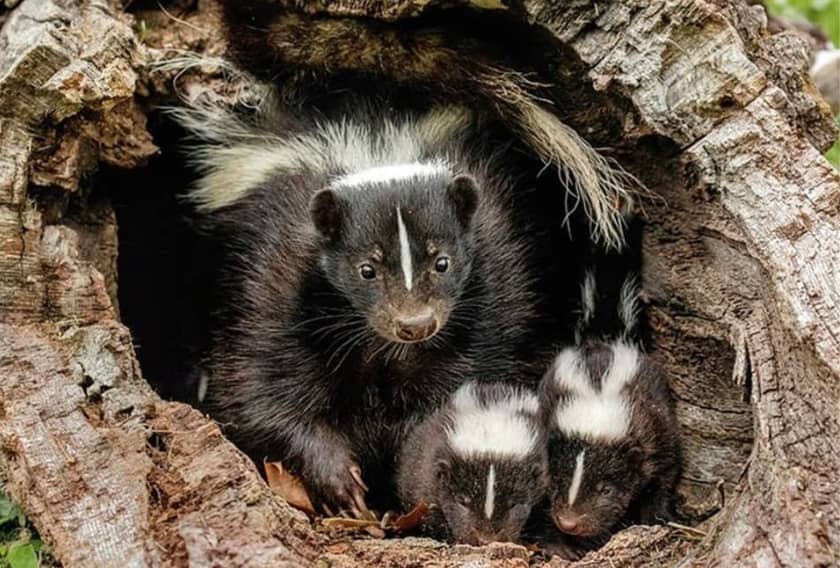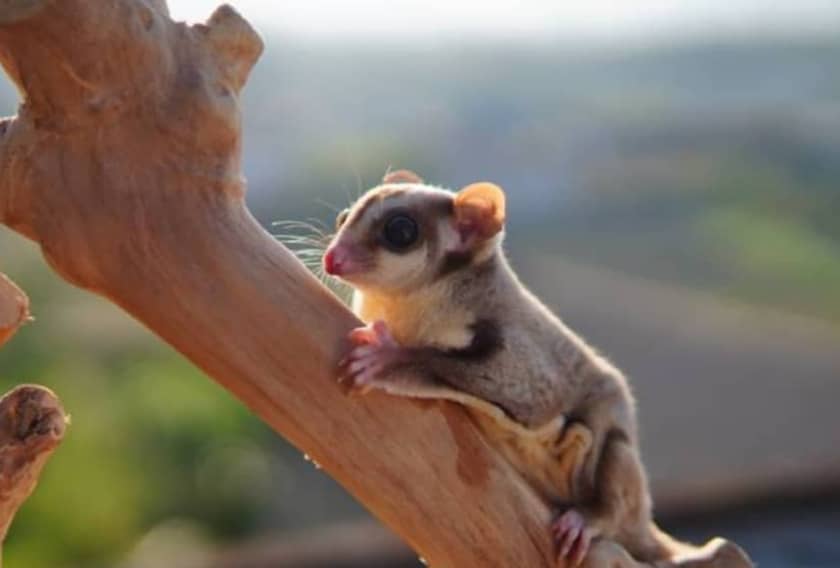Gray short-tailed opossums, also known as Monodelphis domestica, are members of the Didelphidae family. They are native to Brazil and other countries in South America. It is also found in eastern Bolivia, northern Paraguay, and in Formosa Province in northern Argentina. Gray short-tailed opossum inhabits rainforest environments, scrubland, and agricultural land and often enters the houses of humans.
It gets its scientific name “domestica” due to its reputation for entering human dwellings. Opossum means “double-wombed” in Greek.

Opossum’s teeth are very sharp. Opossum hair is grayish brown over their entire body and paler shade on the underparts with off-white fur on the feet. Opossum tail has no fur except at the base. Their claws are well-developed and curved in shape. The Opossum skull is long and narrow. They have large ears and big eyes to give good night vision. Their hind legs are longer than their front legs.
They are very fast, and male opossums are larger than females. They are omnivores, carnivores, or scavengers and feed on small rodents, reptiles, amphibians, insects, and fruits.
Size Information and Life Expectancy of the Gray Short-Tailed Opossum
Gray short-tailed opossums are small marsupials. The size of the gray short-tailed opossum measures 4–7.8 inches long, including the tail. They generally weigh approximately 3-5 ounces, making them lightweight creatures.
The pet opossum’s lifespan is 2 years old when they are in the wild. Whereas, in captivity, with proper care, they can live 4-6 years.
Behavior and Temperament of the Gray Short-Tailed Opossum
The gray short-tailed opossums are solitary, nocturnal creatures that prefer to forage at night, searching for food such as insects, small rodents, fruits, and other small prey. are not social animals and thrive when kept alone. Unlike some other pets, they do not require companionship from other opossums, as they are solitary by nature.

Unlike other opossums, they lack a pouch, as they are members of the “pouchless” opossum family. They are very curious, entertaining, and intelligent creatures. They hunt primarily by scent and poke their snout into vegetation in search of dead animals to scavenge.
How to Care for the Short-Tailed Opossum?
Although they are easy to care for, gray short-tailed pet opossums have some special requirements to keep them healthy and happy.
What Do Gray Short-tailed Opossums Eat?
Gray short-tailed opossums are omnivores; thus, their food should include a variety of proteins, fruits, and vegetables. In captivity, opossums eat a commercial insectivore diet supplemented with live insects like crickets and mealworms because they are rich in protein and high in fats. You can also give some treats like apples, bananas, carrots, and sweet potatoes, which fulfill their requirements of minerals, vitamins, and fiber.
Some people successfully feed short-tailed opossum cat food, ferret food, and a range of other pellet diets. You can occasionally give multivitamin supplements, which can be beneficial, but these should be used sparingly to avoid over-supplementation. Fresh, clean water should always be available. Water should be changed daily to ensure cleanliness. Some owners prefer using water bottles designed for small animals to keep the water clean and prevent spills.
Feeding Schedule:
Opossums eat in the evening because they are nocturnal and more active at night. Provide a well-balanced meal that includes protein, fruits, and vegetables. Feeding in little portions on a regular basis helps to prevent overeating and promotes a healthy weight.
Foods to Avoid pet opossums
Not all foods are safe for gray short-tailed opossums. Avoid these to keep your pet healthy.
- Citrus fruits
- High-fat foods (meats, fried food, junk food)
- Dairy products: Most opossums are lactose intolerant and can develop digestive issues from consuming dairy.
- Processed foods: Stick to natural, whole foods and avoid those with added sugars, salt, or preservatives.
The housing of Pet Opossums
An ideal habitat must be present for your opossum. The enclosure should be at least 20x20x30 inches. They require a large, well-ventilated habitat with plenty of hiding spots and opportunities for climbing. A wire cage intended for tiny animals, such as hamsters or rats, is usually suitable. They are active, so the enclosure must have numerous levels, platforms, and branches for climbing and exploring. The temperature of the enclosure should be kept at 70 to 80°F.
You should provide nesting materials like soft, shredded paper, fleece, or cotton. Gray short-tailed opossums like building nests and burrowing into cozy bedding, make them feel comfortable and secure. The cage should be maintained clean with bedding that is easily replaceable. Regular cleaning is required to prevent the accumulation of garbage or bacteria that might endanger your opossum’s health.
Specific Substrate Needs
The enclosure’s floor should be coated with a waste-absorbing and easily cleanable material such as aspen shavings, recycled paper bedding, or coconut fiber. Avoid using pine or cedar shavings since they are poisonous to opossums. To keep your opossum mentally stimulated, provide toys like miniature hammocks, tunnels, and foraging toys. Puzzle feeders and hidden treats in toys stimulate natural foraging behaviors.
How to Handle a Pet Opossum?
Gray short-tailed opossums are not violent in nature, although they are not as cuddly as some other little pets. When handled by a young baby opossum, they can grow tame and adjust to human interaction. Still, it’s important to treat them carefully and with care. As they are nocturnal, the best time to engage with them is in the evening when they are more active. You can allow them to roam outside of their cage in a secure, supervised setting, which can offer them excitement and exercise.
Opossums can be shy or defensive if they are not used to handling. Approach them slowly and avoid sudden movements to prevent startling them. Before handling your opossum, wash your hands to remove any odors or substances that might irritate them. This also helps prevent the spread of bacteria.
Health Issues of Gray Short-tailed Opossums
Some common health problems for pet opossums include hair loss from the rump, diarrhea, dehydration, and other nutritional deficiencies.
Hair Loss Around the Rump:
It occurs due to protein deficiency and allergy to cage bedding. Bedding materials like pine or aspen can cause skin irritation or allergic reactions. It can be corrected by proper intake of a balanced diet including protein like insects or eggs. You can also switch to hypoallergenic bedding materials such as recycled paper or cloth.
Diarrhea from New Foods:
This can occur when introducing new foods too quickly or providing unsuitable items in your opossum’s diet. Make sure to introduce new foods gradually and that their diet remains balanced with fruits, vegetables, and proteins.
Dehydration:
This can occur from a lack of water. So you should ensure to give fresh and clean water always.
Bacterial Infections:
Opossums are susceptible to respiratory infections like pneumonia, especially if exposed to drafts, cold temperatures, or bacterial infections. So, it is important to keep their living area warm, dry, and free from drafts. Ensure their environment is clean to reduce the risk of bacterial infections. If you see any symptoms like coughing, wheezing, or difficulty breathing occur, seek veterinary care immediately.
Can Opposum Get Rabies?
Rabies is a serious viral disease that affects the nervous system of pet opossums and can be transmitted to humans and other animals through bites or scratches. The risk of opossum rabies is considered very low compared to other wildlife such as bats, raccoons, and foxes. This is because opossums have a relatively strong immune system that may help them resist the rabies virus. In the rare cases where an opossum might contract rabies, the symptoms could be behavioral changes, difficulty moving, seizures, or physical symptoms like paralysis or difficulty swallowing.
In that case, it’s essential to avoid direct contact with wild opossums, especially if they are behaving unusually. Do not attempt to handle or interact with them, and keep pets away from wildlife.
Veterinary Treatment
Not all veterinarians are trained to care for exotic pets like gray short-tailed opossums. It’s essential to find a veterinarian with experience treating small mammals and marsupials. Exotic pet veterinarians are an ideal choice to address the specific health needs of opossums. You should ensure to get regular checkups of your opossum. Regular veterinary visits, proper diet, and attentive handling are essential for maintaining the well-being of these marsupials.
Grooming
Like house cats, short-tailed opossums are very particular about their hygiene and spend a lot of time using their tongues and paws to brush themselves. As a result, you won’t need to do much in the way of grooming your short-tailed opossum; they will do everything by themselves. In case your opossum becomes disoriented and needs a bath, you have two options: use chinchilla dust as a dust bath or use a mild pet shampoo.
Ethics and Legality of Keeping Gray Short-tailed Opossums
Short-tailed opossums are not allowed to be kept as pets in all states.
Legality
To find out if owning a Short-Tailed Opossum (STO) is permitted in your location, check the codes for your state, county, city, and municipality. To obtain your STO, find out if you require any permits. If you live in an apartment, find out whether pets are allowed by contacting the complex. The Department of Natural Resources, or Fish & Game, are the state organizations that often oversee the ownership of exotic pets.
To own an STO, you do not require a USDA license. As of June 2006, retail pet stores and all other breeders are required to have a valid USDA license to sell STO; hobby breeders with three or fewer breeding females are exempt from this requirement. Some states and cities require proof that your exotic pet was purchased legally, so get a receipt from the pet store or breeder.
Ethics
Like other pets, ethical pet ownership frequently goes down to the kind of life you can give your animal companion. Be sure you have the resources and time to spend on the upkeep of a short-tailed opossum before bringing one into your home. Even though owning one might be legal, it won’t be moral if you can’t give it the necessary level of care.
Where to Buy?
The most reliable way to purchase a gray short-tailed opossum is through breeders who specialize in exotic pets. These breeders often have experience raising opossums in healthy environments and can provide you with information about their health, diet, and care requirements. Some pet stores that specialize in exotic animals may offer gray short-tailed opossums for sale. Be sure to choose a pet store with knowledgeable staff who can guide the proper care of the animal. Prices for the gray-colored short-tailed opossums usually range from $50-$100 depending on geographic availability.
Reproduction and Breeding of Gray Short-tailed Opossums
A short-tailed opossum will shelter in nests they construct themselves. Females of this species are known to create intricately woven nests. They may raise up to 6 litters of 6 to 11 baby opossums in a good year, and they breed year-round when the climate is favorable.
The gestation period of a short-tailed opossum is 14 to 15 days. Once the babies are born, they crawl onto their mother’s stomach and attach to a teat until they are weaned. Because short-tailed opossums don’t have pouches like the Virginia Opossum, their young are weaned much earlier. The young of the short-tailed opossum is, on average, weaned at 3 weeks.
Related Species
The species related to the gray short-tailed opossums are:
- Skunk (Mephitis mephitis)
- Sugar Glider (Petaurus breviceps)
- Wallaroo (Macropus robustus)
Opposum vs. Possum
| Feature | Opposum | Possum |
| Geographic Location | North America, Eastern Bolivia, and northern Paraguay | Australia, New Zealand, and surrounding islands |
| Appearance | Long snout, grayish body, naked ears | Furry, with a rounded face and thick fur |
| Scientific Name | Didelphimorphia | Phalangeridae |
| Common Species | Virginia Opossum (Didelphis virginiana) | Common Brushtail Possum (Trichosurus vulpecula) |
| Habitat | Forests, urban areas, wetlands | Forests, urban areas, woodlands |
| Size | Generally larger, 2-4 kg | Smaller, 1-2 kg |
| Defense Mechanism | “Playing dead” (thanatosis) | Hiss, growl, or escape; generally docile |
| Breeding Season | Breeds multiple times a year, typically from January to July | Breeds seasonally, usually from May to July |
| Sexual Maturity | Reaches sexual maturity by 6-12 months | Reaches sexual maturity by 12-14 months |
Pros and Cons of Keeping Gray Short-tailed Opossums
Pros
- Low Maintenance: They don’t require as much attention as larger pets. With proper setup, they are fairly independent.
- Their small size (4-5 inches) makes them easy to handle and care for in limited space.
- Unlike other marsupials, gray short-tailed opossums are naturally solitary, so they do not require companionship, which is beneficial if you don’t want multiple pets.
- They are very active and intelligent animals.
- Unlike rodents, they don’t produce much odor, and they are relatively clean animals, as they groom themselves frequently.
Cons
- They are primarily active at night, which may disrupt your schedule if you prefer more active interaction during the day.
- They live only 3-5 years in captivity, which is shorter than many other small pets.
- They need a properly maintained habitat, including the right temperature, humidity, and diet. Inappropriate care can quickly lead to health problems.
- Finding a veterinarian familiar with gray short-tailed opossums can be challenging, especially if they need specialized care.

Some Interesting Facts Related to Gray Short-tailed Opossums
- Opposums can eat venomous snakes.
- Opossums are the only marsupial species native to North America.
- Gray short-tailed opossums don’t have true pouches like most other marsupials.
- The oldest opossum fossils are 20 million years old.
- When threatened, opossums may involuntarily enter a catatonic state, commonly known as “playing dead” or thanatosis.
- Opossums have 50 teeth, more than any other North American land mammal.
- Opossums use their tails for balance and grip, but they don’t hang by their tails for long periods.

Frequently Asked Questions
Question 1: Where to Spot Opossum Tracks?
Answer: Opossum tracks are fairly easy to distinguish due to their opposable thumbs, which give the prints a unique, hand-like appearance. In the wild, in their natural habitat, you can find tracks in soft dirt, mud, or sand near their foraging areas. Opossums are nocturnal, so their tracks are most often left during the night.
Question 2: How to get rid of opossums?
Answer: To get rid of opossums, you can remove food sources like pet food and trash, seal off entry points to your home, and clear shelters like brush piles. You can install motion-activated lights or sprinklers, which can deter them from your yard. You can also use natural repellents or humane traps to relocate them, following local wildlife regulations.
Question 3: What are the risks of touching or taking care of opossums found in the wild?
Answer: Touching or taking care of opossums found in the wild can pose health risks, as they may carry parasites like fleas, ticks, or diseases such as leptospirosis and salmonella. Additionally, opossums may bite or scratch if they feel threatened. It’s best to avoid direct contact and let wildlife professionals handle them to ensure both your safety and the well-being of the animal.
Question 4: How much does a pet opossum cost?
Answer: Prices for the gray-colored short-tailed pet opossums usually range $50-$100 depending on geographic availability.
Question 5: Do opossums make good pets? Are they the same as possums?
Answer: Opossums generally do not make good pets as they are wild animals with specific needs and behaviors that are difficult to manage in a home environment. They are also prone to stress in captivity. While “opossums” are native to the Americas, “possums” refer to a different species found in Australia and are not the same animal, despite their similar names. Both are different in their natural habitats.
Conclusion
In conclusion, gray short-tailed opossums are fascinating and unique creatures known for their adaptability and resilience. Though small in size, they play a vital role in their ecosystems as both prey and scavengers, helping to control insect populations and clean up the environment. While they can be intriguing as exotic pets, their care requires specialized knowledge and attention. Still, these opossums are best appreciated in the wild, where they thrive in their natural habitat and show their distinct behaviors and characteristics.



